Yoshinoya
Yoshinoya (𠮷野家, TYO: 9861) is a Japanese multinational fast food chain, and the second-largest chain of gyūdon (beef bowl) restaurants. The chain was established in Japan in 1899. Its motto is "Tasty, low-priced, and quick".[1]
 The flagship restaurant in Tsukiji fish market in Tokyo in May 2008 | |
| Type | Public KK |
|---|---|
| TYO: 9861 | |
| Industry | Foodservice |
| Founded | Tokyo, Japan (1899) |
| Founder | Eikichi Matsuda (松田栄吉) |
| Headquarters | Kita, Tokyo, Japan |
Areas served | East Asia Southeast Asia United States |
Key people | Shuji Abe, President and CEO |
| Products | Fast food |
Number of employees | 1,107 |
| Website | yoshinoya.com YoshinoyaAmerica.com |
Etymology
The kanji 吉 (yoshi) means "luck" in Japanese, the kanji 野 (no) means "field", and the kanji 家 (ya) means "house".
The founder of the company, Eikichi Matsuda (松田栄吉), was from the former town of Yoshino (吉野町) in Osaka Prefecture, and a belief predominates that Yoshino is the origin of the name.[2]
In Japan, the nickname of the restaurant is "yoshigyū" (吉牛), which is an abbreviation of Yoshinoya no gyūdon (吉野家の牛丼, Yoshinoya's gyūdon).
Logo
The logo of Yoshinoya resembles a bull horn, and was invented by Yoshinoya's founder Eikichi Matsuda. The idea of the bull horn was derived from the initial letter of Yoshinoya's English name, "Y". The rope surrounding the horn represents a in Japanese sumo-wrestling, "Yokozuna" (equivalent to "winner"), representing the quality of the food served in Yoshinoya. The surrounding rope is made up of 27 rice grains. The logo as a whole is meant to suggest that Yoshinoya sells the "best beef bowls".[3]
History
Yoshinoya first opened in 1899 at the Nihonbashi fish market in Tokyo.[4] When the market was devastated by the Great Kantō earthquake, Yoshinoya moved to the new Tsukiji fish market in Tokyo in 1926.
The chain opened its first 24-hour store in 1952.
On December 27, 1958, the chain's business model was changed from self-employed restaurants to a stock company, as an attempt to gain more profit.
In 1965, the chain earned a million dollars in sales, which led to the idea of expanding the chain's operations in Japan.
The chain's first franchised store was opened in Shinsaibashi, in 1968.
In 1975, the first American store of the fast-food chain was opened in Colorado.
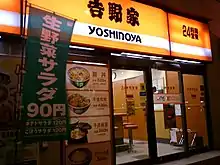
In the early 2000s, Yoshinoya, along with other chains such as McDonald's, triggered a price war in Japan by introducing a regular beef bowl dish for 280 yen, or around US$3.[5]
Controversies in the 2000s
In late 2001, a domestic bovine spongiform encephalopathy (BSE) incident critically damaged beef bowl sales. In late 2003, Japan suspended imports of American beef due to a BSE incident in Washington, cutting off Yoshinoya's main source of short plate (fatty beef) that is the main component of its beef bowl. This forced Yoshinoya to terminate beef bowl sales in Japan for the first time in its history on February 11, 2004.
News of the removal of this item from Yoshinoya's menu caused its fans and non-fans alike to queue in massive lines at its restaurants all around Japan to taste what might be their last beef bowl for a long time. Yoshinoya then switched to serving pork bowl (butadon) instead of beef. However, its restaurants in the United States continued to serve the beef bowl using American short plate. From December 2, 2004, restaurants in Japan started serving "beef yakiniku bowls" (牛焼肉丼, gyū-yakiniku-don), which use Australian beef, a different sauce, and additional vegetables.[6] These bowls differed from original "beef bowls", which use American beef.
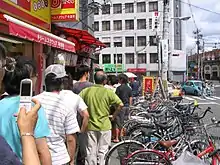
In December 2005, Japan agreed to remove the restriction on importing beef from the United States. A letter to customers was then put up in restaurants, promising that the beef bowl would return in a few months. In January 2006, imports stopped again because inspectors found banned cattle parts in a veal shipment from the United States. In June 2006, Japan lifted the ban on imports again, and on July 31, 2006, Yoshinoya reposted the letter promising to resume serving the beef bowl in about two months.
On September 18, 2006, Yoshinoya brought back their beef bowl for one day as "the beef bowl revival festival" (牛丼復活祭, gyūdon fukkatsusai). This "revival", however, meant that its beef bowls would be available only the first five days of the month in October and November. On December 1, 2006, they began serving beef bowls daily, albeit at limited hours. These hours were extended once during special campaigns in February and December 2007. By March 17, 2008, Yoshinoya announced that they would resume 24-hour sales of the beef bowl, rolling out through their then 1040 stores nationwide through March 20, 2008. An announcement of banned cattle products in a Californian beef import on April 21, 2008, did not halt the company's plans, as they felt they had enough stock from other sources to avoid a recall.
In 2019, Yoshinoya outlets in Hong Kong were targeted to be boycotted and vandalized by anti-government protesters during 2019–20 Hong Kong protests. Hop Hing Group, based in Hong Kong, is the licensed franchise of Yoshinoya in the city and Mainland China (Beijing and the cities in Southeast China). Its CEO Marvin Hung was criticized by protesters for attending a rally for Hong Kong police organized by pro-Beijing camps.[7]
Another major reason that caused the boycott of Yoshinoya is about an advertisement posted on Facebook in July 2019. The advertisement featured a traditional Japanese food, chikuwa; in Cantonese, the word sounds similar to "dog that tears paper". As this advert was published after a police removed messages on a Lennon Wall in Tai Po, the advertisement was then regarded as poking fun at the police. The staff from Social Strategy Hong Kong who helped created the advertisement was sacked afterwards. Hence, the public thought that Yoshinoya was politically biased and suppressed freedom of speech. Citizens in support of the current social movement then started boycotting Yoshinoya.[8]
Locations
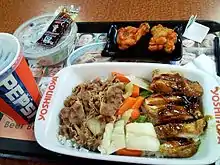
Yoshinoya has a chain of stores in Japan, the United States, Hong Kong, Cambodia, China, Indonesia, Malaysia, Philippines, Singapore, Taiwan, and Thailand.
Japan
In its restaurants in Japan, tables are often counters, and in that case, they take orders over those counters. Chopsticks are provided. The menu includes standard-serving (nami, or namimori, 並盛), large-serving (ōmori, 大盛), or extra-large-serving (tokumori, 特盛)[9] beef bowls, pork bowls (butadon, 豚丼),[10] raw eggs (to stir and pour on top, sometimes mixed with soy sauce), soft-boiled eggs (hanjuku tamago, 半熟玉子), miso soup and pickles (called oshinkō [お新香] in its menu; a kind of asazuke). They also serve red ginger (beni shōga), spice, and Japanese tea (ocha, お茶) free of charge. Some menus including raw eggs and miso soup can be taken out.
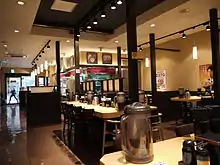
Some customers make special requests at no extra charge such as: extra gravy sauce (tsuyudaku, つゆだく), extra onions (negidaku, ねぎだく), without gravy sauce (tsuyunuki, つゆ抜き), no onions (neginuki, ねぎ抜き),[12] egg-yolk only (kimidake, 黄身だけ) and less rice (karui no, 軽いの; literally "light one").
On June 14, 2011, Yoshinoya in Japan started serving eel bowls (unadon, 鰻丼) as a standard seasonal menu to be offered until the latter part of July.[13]
United States

Yoshinoya entered the United States opening a corporate office in Denver in 1973, and then its first retail location in Denver in 1975.[14] (This location later became "Kokoro", a similar restaurant run by Mas Torito who had previous experience at a location in Japan.) Yoshinoya is currently only present in California. A location in Las Vegas, Nevada, closed in February 2017.[15] A location in Goodyear, Arizona, opened in 2008, but was closed in December 2011. A Dallas location that opened in June 2011 was Yoshinoya's first venture into Texas.[16] But it closed in December of that year. The first location east of the Mississippi River opened on 42nd Street off Times Square, New York City, in 2002.[17] Two more stores opened in other Manhattan locations, but all the New York City stores closed by January 2012.
In March 2020, indoor dine-ins were abandoned, with take-away, drive-thru or pick-up service still available.
The main menu in the United States includes the beef bowl, chicken bowl, combo bowl, and shrimp bowl, along with soup and desserts, and has variations such as "beef with vegetables bowls", "teriyaki chicken bowls", and barbecue-style plates. Skinless chicken is available upon request. Tempura bowls are no longer available. The menu of Yoshinoya in the U.S. is similar to that in Japan. At a basic level, both companies serve several recipes over a bowl of rice, which includes the trademark beef bowl with very thinly sliced beef plus light sauce and onions.
Hong Kong
The Hong Kong division of Yoshinoya was founded in 1991. Currently 57 Yoshinoya food stores are split among three main areas: the Hong Kong branch, the New Territories branch, and the Kowloon branch. Fourteen stores are in the Hong Kong branch, 21 stores are in the New Territories branch, and 22 stores are in the Kowloon branch. Each Yoshinoya food store has five working positions: store manager, supervisor, customer service assistant, crew, and production assistant.[3] Unlike the Yoshinoya in Japan, stores in Hong Kong do not provide table services. Customers order their food at a cashier and collect their food on a tray there, which is the same as in western fast-food stores.
Gallery
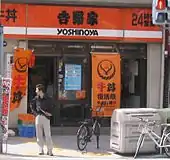 Yoshinoya in Teradachō, Osaka city, on September 18, 2006
Yoshinoya in Teradachō, Osaka city, on September 18, 2006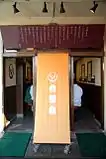 The flagship restaurant in Tsukiji fish market in Tokyo
The flagship restaurant in Tsukiji fish market in Tokyo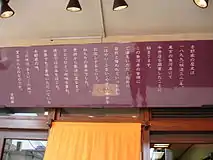 Greetings to customers at the flagship restaurant
Greetings to customers at the flagship restaurant Free banner given to customers in "the beef bowl revival festival" on September 18, 2006
Free banner given to customers in "the beef bowl revival festival" on September 18, 2006
See also
References
- "吉野家公式ウェブサイト". 吉野家公式ウェブサイト.
- "吉野家の歴史に関するご質問." (Japanese) YOSHINOYA CO., LTD. Retrieved July 6, 2011.
- Hong Kong Yoshinoya official website: "Archived copy". Archived from the original on October 11, 2012. Retrieved October 4, 2012.CS1 maint: archived copy as title (link)
- "Tsukiji". Archived from the original on January 6, 2009. Retrieved April 10, 2010.
- Nagata, Kazuaki (2014-04-28). "No sacred cows in Japan's beef bowl war". The Japan Times Online. ISSN 0447-5763. Retrieved 2015-10-06.
- Press release "Archived copy" (PDF). Archived from the original (PDF) on May 22, 2011. Retrieved April 10, 2010.CS1 maint: archived copy as title (link) (Retrieved on April 10, 2010)
- Hong Kong protesters trash Starbucks and Yoshinoya
- "Yoshinoya steams at ad agency as extradition rows rock workplaces". South China Morning Post. 2019-07-12. Retrieved 2020-03-03.
- "吉野家メニュー: 牛丼・牛皿." (Japanese) YOSHINOYA CO., LTD. Retrieved July 6, 2011.
- "吉野家メニュー: 豚丼・豚皿." Archived July 9, 2011, at the Wayback Machine (Japanese) YOSHINOYA CO., LTD. Retrieved July 6, 2011.
- 吉野家の牛丼、頼み方は72種類 (2008). Retrieve June 19, 2011, from http://www.gamenews.ne.jp/archives/2008/03/72_1.html
- "吉野家 夏の定番メニュー 「鰻丼」期間限定発売のお知らせ." (Japanese) (pdf) YOSHINOYA HOLDINGS. June 9, 2011. Retrieved July 5, 2011.
- "History of Overseas Expansion". www.yoshinoya-holdings.com.
- "Yoshinoya - CLOSED - University - Las Vegas, NV". Yelp.
- "Archived copy". Archived from the original on May 19, 2011. Retrieved May 24, 2011.CS1 maint: archived copy as title (link)
- "Yoshinoya". Retrieved 23 December 2015.
External links
| Wikimedia Commons has media related to Yoshinoya. |
- Yoshinoya Co., LTD. (in Japanese)
- Yoshinoy Holdings Co., LTD. - Executive board members (in Japanese)
- Yoshinoya America(in English)
- Yoshinoya Philippines (in English)
- Yoshinoya Singapore (in English)
- Yoshinoya Hong Kong (in Chinese)
- "Yoshinoya: The Videogame - Video Review" at "BN-Games.com (in English)
- Why Yoshinoya America Yucks Compared to Yoshinoya Globally
